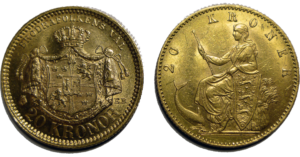Gold Standard

The payment of a trade by money in the form of bills and coins is simply more practical than exchange of goods. But this can only work, if the contracting parties are convinced of the quality of money:
- Long-term value stability
- Forgery save
- Can be exchanged at any time to a recognized value-stable reserve good
- Issued by a state authority
- Money supply oriented to economic power
The gold standard is a monetary scheme in which the currency (the money) consists of either gold coins or banknotes that represent a claim to gold and can be exchanged at any time in gold.
The gold standard was introduced in the United States with the Gold Standard Act of 1900.
In the simplest case, embossed Gold act directly as money (commodity money). However, a gold standard also exists when a Central Bank or National Bank guarantees a fixed exchange rate of its currency in banknotes to gold and is in fact able and willing to exchange at any time for the entire amount.
In the case of the pure gold standard, the money supply of a country corresponds to the value of the monetary gold holdings of that country (gold reserve).
There is, in principle, a system of fixed exchange rates between countries subjected to a pure gold standard. There is in addition among other things, the proportional system, in which only part of the money supply is held as gold stock.
The monetary regime of the gold standard had prevailed around the year 1870 and had become the recognized system in the developed countries beginning 1880.
With the increased use of banknotes and deposit money, at the end of the 19th century, the amount of money developed far beyond the amount possible with a gold standard. At the beginning of the 20th century, the pure gold standard changed towards a proportional System.